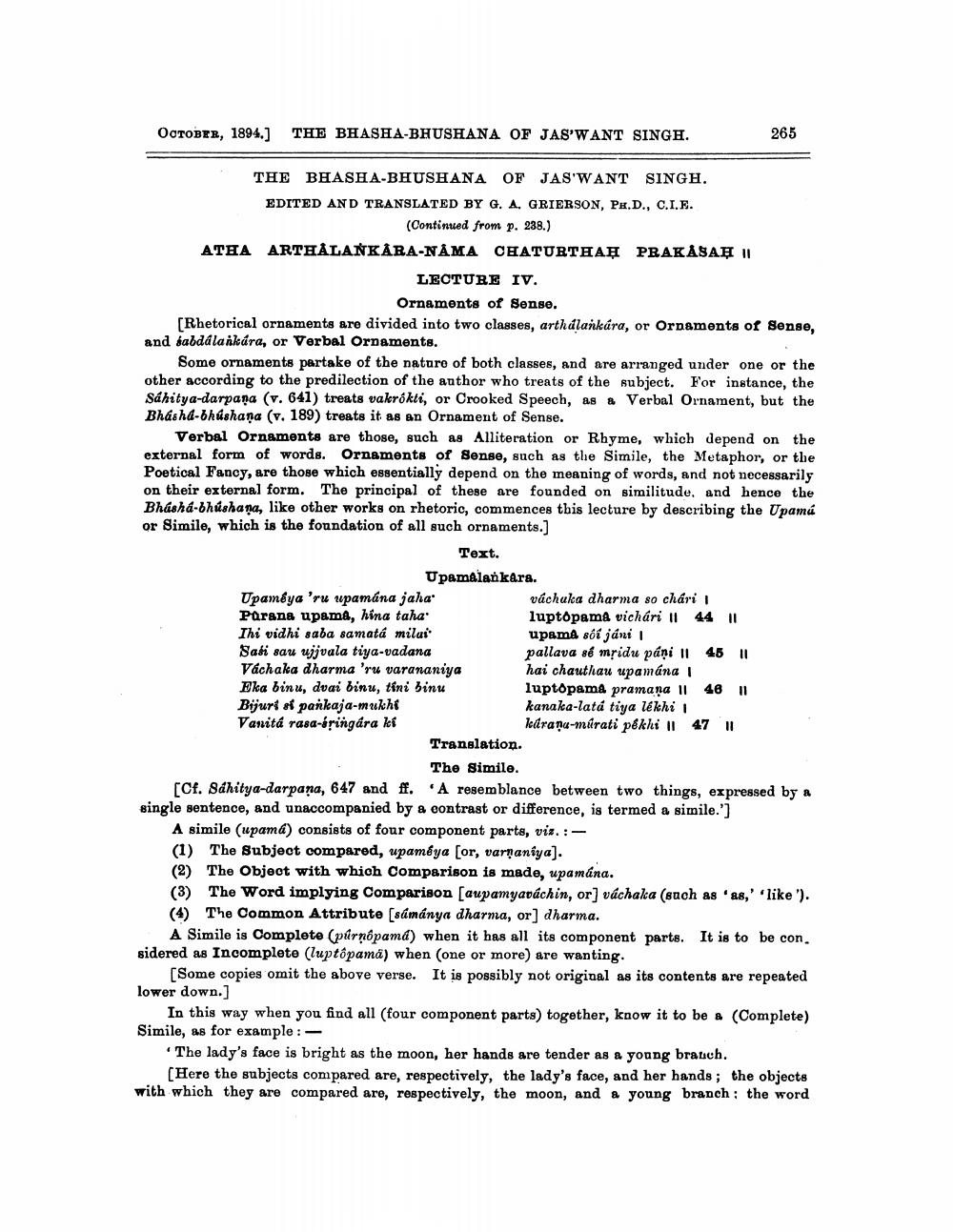________________
OCTOBER, 1894.)
THE BHASHA-BHUSHANA OF JAS'WANT SINGH.
265
THE BHASHA-BHUSHANA OF JAS'WANT SINGH. EDITED AND TRANSLATED BY G. A. GRIERSON, PH.D., C.I.E.
(Continued from p. 238.) ATHA ARTHÅLANKARA-NAMA CHATURTHAY PRAKASAL II
LECTURE IV.
Ornaments of Sense. [Rhetorical ornaments are divided into two classes, arthalankára, or Ornaments of Sense, and sabdálankára, or Verbal Ornaments.
Some ornaments partake of the nature of both classes, and are arranged under one or the other according to the predilection of the author who treats of the subject. For instance, the Sáhitya-darpana (v. 641) treats vakrókti, or Crooked Speech, as & Verbal Ornament, but the Bhasha-bhishana (v. 189) treats it as an Ornament of Sense.
Verbal Ornaments are those, such as Alliteration or Rhyme, which depend on the external form of words. Ornaments of Sense, such as the Simile, the Metaphor, or the Poetical Fanoy, are those which essentially depend on the meaning of words, and not necessarily on their external form. The principal of these are founded on similitude, and hence the Bhasha-bhúshaņa, like other works on rhetoric, commences this lecture by describing the Upamá or Simile, which is the foundation of all such ornaments.]
Text.
Upamalankara. Upamêya 'ru upamana jaha
váchuka dharma so chári 1 Parana upama, hina taha
luptopama vichári 11 44 11 Thi vidhi saba samatá milai
upama sól jáni I Sati sau ujjvala tiya-vadana
pallava sé mridu páni 45 Váchaka dharma 'ru varananiya hai chauthau upamana Eka binu, dvai binu, tini binu
luptopama pramana 11 46 11 Bijuri sf pankaja-mukhi
kanaka-latá tiya lékhi 1 Vanitá rasa-bringára kí
kdrana-márati pêkhi || 47 11 Translation.
The Simile. [Cf. Sahitya-darpana, 647 and ff. 'A resemblance between two things, expressed by a single sentence, and unaccompanied by & eontrast or difference, is termed a simile.']
A simile (upamá) consists of four component parts, viz. :(1) The Subject compared, upaméya (or, varhaniya). (2) The Objoot with which Comparison is made, upamana. (3) The Word implying Comparison [aupamyaváchin, or] váchaka (such as '88,' 'like'). (4) The Common Attribute (sámánya dharna, or] dharma.
A Simile is Complete (púrnopamd) when it has all its component parts. It is to be con. sidered as Incomplete (luptôpamá) when (one or more) are wanting.
[Some copies omit the above verse. It is possibly not original as its contents are repeated lower down.]
In this way when you find all (four component parts) together, know it to be a (Complete) Simile, as for example: -
• The lady's face is bright as the moon, her hands are tender as a young brauch.
[Here the subjects compared are, respectively, the lady's face, and her hands; the objects with which they are compared are, respectively, the moon, and a young branch : the word




